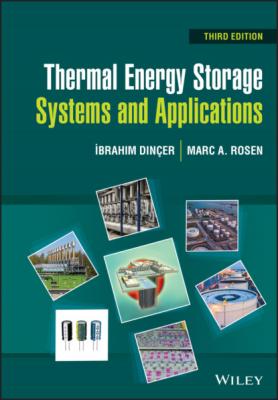Thermal Energy Storage Systems and Applications. Ibrahim Dincer
Читать онлайн.| Название | Thermal Energy Storage Systems and Applications |
|---|---|
| Автор произведения | Ibrahim Dincer |
| Жанр | Физика |
| Серия | |
| Издательство | Физика |
| Год выпуска | 0 |
| isbn | 9781119713142 |
The various kinds of forced convection, such as flow in a tube, flow across a tube, and flow across a flat plate, may be solved mathematically when certain assumptions are made with regard to the boundary conditions. It is extremely difficult to obtain exact solutions to such problems, especially in the event of turbulent flow, but approximate solutions can sometimes be obtained using appropriate assumptions.
The essential first step in the solution of a convection heat transfer problem is to determine whether the boundary layer is laminar or turbulent. These conditions affect the convection heat transfer coefficient and hence the convection heat transfer rates.
The conditions of laminar and turbulent flows on a flat plate are shown in Figure 1.13. In the laminar boundary layer, fluid motion is highly ordered and it is possible to identify streamlines along which particles move. Fluid motion in the turbulent boundary layer, on the other hand, is highly irregular, and is characterized by velocity fluctuations that begin to develop in the transition region (after this, the boundary layer becomes completely turbulent). These fluctuations enhance the transfer of momentum, heat, and species, and hence increase surface friction as well as convection transfer rates. In the laminar sublayer, which is nearly linear, transport is dominated by diffusion and the velocity profile. There is an adjoining buffer layer in which diffusion and turbulent mixing are comparable. In the turbulent region, transport is dominated by turbulent mixing.
The critical Reynolds number is the value of Re for which transition begins, and for external flow it is known to vary from 105 to 3 × 106, depending on the surface roughness, the turbulence level of the free stream, and the nature of the pressure variation along the surface. A representative value of Re is generally assumed for boundary layer calculations:
(1.122)
For smooth circular tubes, when the Reynolds number is less than 2100, the flow is laminar, and when it is greater than 10 000, the flow is turbulent. The range between these values represents the transition region.
We give a list of various forced‐convection heat transfer correlations (the Nusselt–Reynolds correlations), direct convection heat transfer coefficient equations, along with the relevant parameters and remarks, which are compiled from literature in Table 1.11. In many of these equations, the film temperature is used, and is defined as Tfm = (Ts + Ta)/2.
1.7 Concluding Remarks
In this chapter, a summary is presented of general introductory aspects of thermodynamics, fluid flow, and heat transfer, and related fundamental definitions and physical quantities, to provide a sufficient thermal sciences background for understanding TES systems and applications, and their operations. The background provided here is also useful in the energy, exergy, and other analyses presented subsequently.
Table 1.11 Forced‐convection heat transfer equations and correlations.
Source: Dincer and Rosen [9].
| Equation or correlation |
| • Correlations for flat plate in external flow |
|
|
| • Correlations for circular cylinders in cross‐flow |
| Nu = cRenPr1/3 for Pr ≥ 0.7 for average; Tfm; 0.4 < Re < 4 × 106 |
| where |
| c = 0.989 and n = 0.330 for 0.4 < Re < 4 |
| c = 0.911 and n = 0.385 for 4 < Re < 40 |
| c = 0.683 and n = 0.466 for 40 < Re < 4000 |
| c = 0.193 and n = 0.618 for 4000 < Re < 40 000 |
| c = 0.027 and n = 0.805 for 40 000 < Re < 400 000 |
| Nu = cRenPrs(Pra/Prs)1/4 for 0.7 < Pr < 500 for average; Ta; 1 < Re < 106 |
| where |
| c = 0.750 and n = 0.4 for 1 < Re < 40 |
| c = 0.510 and n = 0.5 for 40 < Re < 1000 |
| c = 0.260 and n = 0.6 for 103 < Re < 2 × 105 |
| c = 0.076 and n = 0.7 for 2 × 105 < Re < 106 |
| s = 0.37 for Pr ≤ 10 |
|
s = 0.36
|
